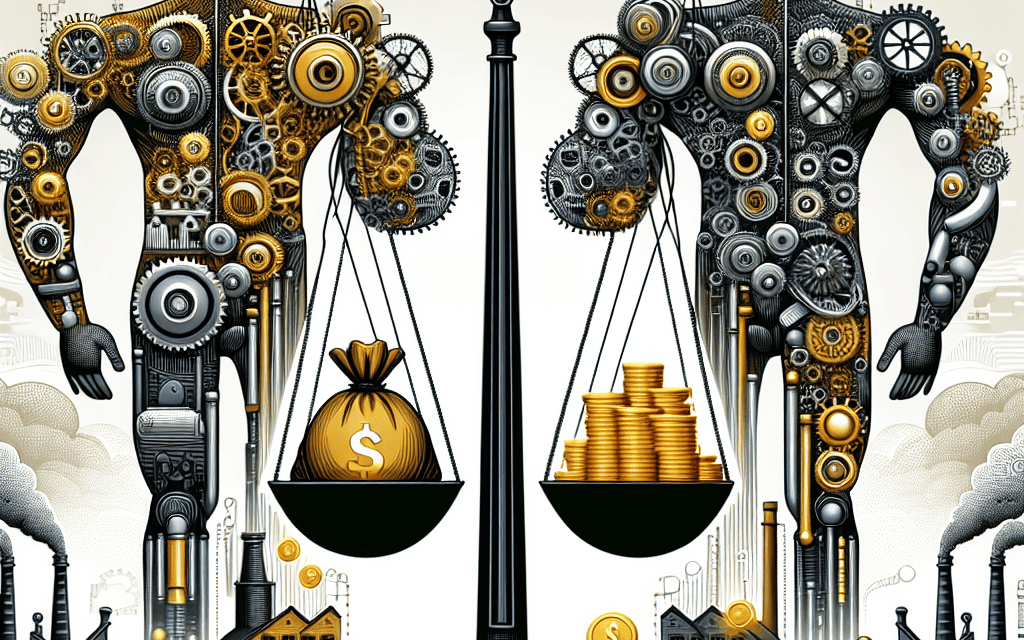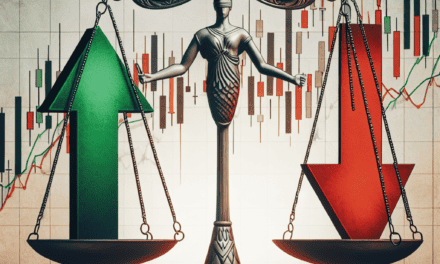“Powering Profits: Industrial Titans Boost Dividends for a Brighter Future”
Introduction
In a significant development for investors and market analysts, two leading industrial giants have announced plans to increase their dividend payouts, signaling robust financial health and a commitment to returning value to shareholders. This move underscores the companies’ confidence in their ongoing growth strategies and operational performance, even amid challenging economic conditions. The decision to enhance dividends reflects their strong cash flow positions and optimistic outlooks, potentially setting a positive tone for the broader industrial sector. As these industry leaders bolster their shareholder returns, the announcements are likely to attract considerable attention from both current and prospective investors, eager to capitalize on the enhanced income opportunities.
Impact Of Increased Dividends On Shareholder Value
The recent announcement by two industrial giants to increase their dividends has sparked considerable interest among investors and financial analysts alike. This strategic decision is poised to have a significant impact on shareholder value, a critical metric for assessing the attractiveness of a company’s stock. By increasing dividends, these companies are signaling their robust financial health and commitment to returning value to shareholders, which can enhance investor confidence and potentially lead to a rise in stock prices.
To understand the implications of increased dividends on shareholder value, it is essential to consider the underlying reasons for such a decision. Typically, companies opt to raise dividends when they have a strong cash flow and a positive outlook on future earnings. This move not only reflects the company’s ability to generate consistent profits but also its willingness to share these profits with its shareholders. Consequently, this can lead to an increase in the perceived value of the company, as investors often view dividend hikes as a sign of stability and growth potential.
Moreover, increased dividends can attract a broader range of investors, particularly those seeking income-generating investments. Dividend-paying stocks are often favored by income-focused investors, such as retirees, who rely on regular dividend payments as a source of income. By raising dividends, companies can appeal to this demographic, potentially broadening their investor base and increasing demand for their shares. This heightened demand can drive up the stock price, further enhancing shareholder value.
In addition to attracting new investors, increased dividends can also strengthen the loyalty of existing shareholders. When companies reward their shareholders with higher dividends, it fosters a sense of trust and satisfaction, encouraging them to hold onto their shares for the long term. This long-term commitment can reduce stock volatility, as a stable shareholder base is less likely to engage in frequent buying and selling. Consequently, this stability can contribute to a more favorable perception of the company’s stock in the market.
However, it is important to consider the potential downsides of increased dividends. While higher dividends can be beneficial, they also represent a cash outflow that could have been reinvested into the company for growth initiatives. Companies must strike a balance between rewarding shareholders and retaining sufficient capital to fund future projects and innovations. If a company prioritizes dividends over reinvestment, it may risk stunting its long-term growth prospects, which could ultimately impact shareholder value negatively.
Furthermore, the sustainability of increased dividends is a crucial factor for investors to consider. A company that raises its dividends must ensure that it can maintain these payments over time. If a company is forced to cut dividends in the future due to financial constraints, it could lead to a loss of investor confidence and a subsequent decline in stock price. Therefore, investors should assess the company’s financial health and earnings stability before interpreting increased dividends as a definitive indicator of enhanced shareholder value.
In conclusion, the decision by two industrial giants to increase their dividends is a multifaceted development with significant implications for shareholder value. While it can enhance investor confidence, attract new investors, and strengthen shareholder loyalty, it also requires careful consideration of the company’s long-term growth strategy and financial sustainability. As such, investors should approach this development with a comprehensive understanding of its potential benefits and risks, ensuring that their investment decisions align with their financial goals and risk tolerance.
Historical Trends In Dividend Increases Among Industrial Giants
In the ever-evolving landscape of the industrial sector, the announcement of increased dividends by two major players marks a significant moment, reflecting broader historical trends in dividend policies among industrial giants. Over the years, dividend increases have often been seen as a signal of financial health and confidence in future earnings, and this recent development is no exception. Historically, industrial giants have used dividend increases as a strategic tool to attract and retain investors, particularly those seeking stable and predictable returns. This practice has roots in the early 20th century when companies began to recognize the importance of shareholder value and the role dividends play in enhancing it.
As we delve into the historical context, it becomes evident that dividend policies have evolved in response to economic conditions, regulatory changes, and shifts in investor expectations. During periods of economic prosperity, industrial companies have typically been more generous with their dividend payouts, capitalizing on robust earnings to reward shareholders. Conversely, during economic downturns, these companies have often been more conservative, opting to preserve cash to weather financial uncertainties. This cyclical nature of dividend policies underscores the delicate balance industrial giants must maintain between rewarding shareholders and ensuring long-term financial stability.
The recent announcement by these two industrial giants to increase dividends is particularly noteworthy in light of the current economic climate. With global markets experiencing volatility and uncertainty, this move can be interpreted as a vote of confidence in their financial resilience and growth prospects. Moreover, it aligns with a broader trend observed over the past few decades, where industrial companies have increasingly prioritized shareholder returns as a key component of their corporate strategy. This shift has been driven, in part, by the growing influence of institutional investors who demand consistent and attractive returns on their investments.
Furthermore, the decision to increase dividends can also be seen as a response to competitive pressures within the industry. As industrial giants vie for market share and investor attention, offering higher dividends can serve as a differentiator, setting them apart from peers who may be more conservative in their payout policies. This competitive dynamic has been a recurring theme in the history of industrial dividend policies, with companies often using dividends as a tool to signal their financial strength and commitment to shareholder value.
In addition to these strategic considerations, the historical trend of increasing dividends among industrial giants is also influenced by regulatory and tax environments. Changes in tax policies, for instance, can impact the attractiveness of dividends relative to other forms of shareholder returns, such as share buybacks. Over the years, industrial companies have had to navigate these regulatory landscapes, adjusting their dividend policies accordingly to maximize shareholder value while complying with legal requirements.
In conclusion, the announcement of increased dividends by two industrial giants is a reflection of historical trends that have shaped dividend policies in the sector. It highlights the strategic importance of dividends as a tool for attracting and retaining investors, while also underscoring the need for companies to adapt to changing economic, competitive, and regulatory environments. As these industrial giants continue to navigate the complexities of the modern financial landscape, their dividend policies will remain a key indicator of their financial health and strategic priorities, offering valuable insights into the broader trends shaping the industry.
Comparing Dividend Strategies Of Leading Industrial Companies
In the ever-evolving landscape of industrial enterprises, the announcement of increased dividends by two leading giants has captured the attention of investors and analysts alike. This development not only reflects the financial health of these companies but also provides a lens through which to examine the broader strategies employed by industrial leaders in managing shareholder returns. As we delve into the dividend strategies of these prominent firms, it becomes evident that their approaches, while distinct, share common objectives aimed at enhancing shareholder value and ensuring long-term sustainability.
To begin with, the decision to increase dividends is often a signal of confidence from a company regarding its future earnings potential. For industrial giants, whose operations are typically capital-intensive and subject to economic cycles, such a move underscores a robust financial position and a positive outlook on future cash flows. By committing to higher dividend payouts, these companies are not only rewarding their shareholders but also reinforcing their commitment to maintaining a balanced capital allocation strategy. This strategy often involves a careful assessment of investment opportunities, debt management, and shareholder returns, ensuring that each component is aligned with the company’s long-term objectives.
Moreover, the increased dividends highlight the importance of maintaining a competitive edge in the industrial sector. As these companies operate in a highly competitive environment, characterized by rapid technological advancements and shifting market demands, the ability to generate consistent cash flows and return capital to shareholders is a testament to their operational efficiency and strategic foresight. By prioritizing dividends, these firms are effectively communicating their resilience and adaptability, which are crucial attributes in navigating the complexities of the industrial landscape.
Transitioning to the specific strategies employed by these companies, it is noteworthy that while both have opted to increase dividends, their underlying approaches may differ. Some industrial leaders may focus on a steady and predictable dividend growth model, which appeals to investors seeking stable income streams. This approach often involves incremental increases in dividend payouts, reflecting a conservative yet reliable strategy that aligns with the company’s long-term growth trajectory. On the other hand, some companies might adopt a more aggressive dividend policy, characterized by substantial increases in payouts during periods of strong financial performance. This strategy can attract investors looking for higher returns, albeit with a potentially higher risk profile.
Furthermore, the decision to increase dividends is often influenced by external factors such as interest rates, inflation, and global economic conditions. In a low-interest-rate environment, for instance, dividends become an attractive option for investors seeking yield, prompting companies to enhance their dividend offerings. Conversely, during periods of economic uncertainty, maintaining or increasing dividends can serve as a stabilizing factor, providing reassurance to investors amidst market volatility.
In conclusion, the announcement of increased dividends by two leading industrial giants serves as a compelling case study in understanding the diverse strategies employed by companies in managing shareholder returns. While their approaches may vary, the underlying objectives remain consistent: to enhance shareholder value, ensure financial stability, and maintain a competitive edge in a dynamic industrial landscape. As these companies continue to navigate the challenges and opportunities of the global economy, their dividend strategies will undoubtedly play a pivotal role in shaping their future trajectories and sustaining investor confidence.
Economic Implications Of Dividend Hikes In The Industrial Sector

In recent developments within the industrial sector, two major corporations have announced significant increases in their dividend payouts, a move that has captured the attention of investors and analysts alike. This decision, while primarily aimed at rewarding shareholders, carries broader economic implications that merit closer examination. As these industrial giants adjust their financial strategies, the ripple effects are likely to influence market dynamics, investor sentiment, and potentially, the sector’s overall economic health.
To begin with, the decision to increase dividends is often interpreted as a signal of financial robustness and confidence in future earnings. By committing to higher payouts, these companies are effectively communicating their optimistic outlook on sustained profitability and cash flow stability. This, in turn, can bolster investor confidence, attracting more capital into the sector. As investors seek stable returns in an uncertain economic climate, dividend hikes can serve as a compelling incentive, potentially leading to an uptick in stock prices. Consequently, this can enhance the market valuation of these companies, further solidifying their standing as industry leaders.
Moreover, the increased dividends reflect a strategic allocation of capital that prioritizes shareholder value. In an era where companies are often scrutinized for their capital management practices, such a move underscores a commitment to returning value to investors. This can be particularly appealing to institutional investors and pension funds that rely on dividend income as a steady revenue stream. As these entities adjust their portfolios to capitalize on the enhanced dividends, there could be a noticeable shift in investment patterns within the industrial sector.
However, it is essential to consider the potential trade-offs associated with this strategy. While higher dividends can be advantageous for shareholders, they may also limit the funds available for reinvestment in growth initiatives. In industries characterized by rapid technological advancements and evolving market demands, the ability to invest in research and development, infrastructure, and innovation is crucial. Therefore, these companies must strike a delicate balance between rewarding shareholders and ensuring long-term competitiveness.
Furthermore, the broader economic implications of these dividend hikes extend beyond the companies themselves. As industrial giants, their financial decisions can have a cascading effect on the supply chain, impacting suppliers, partners, and even competitors. For instance, suppliers may experience increased demand as these companies ramp up production to meet market expectations. Conversely, competitors may feel pressured to follow suit with similar dividend increases to remain attractive to investors, potentially leading to a sector-wide shift in capital allocation strategies.
In addition, the timing of these announcements is noteworthy, as they come amidst a backdrop of global economic uncertainty. With inflationary pressures, fluctuating commodity prices, and geopolitical tensions influencing market conditions, the decision to increase dividends can be seen as a bold statement of resilience. It suggests that these companies are not only weathering the storm but are also poised to capitalize on emerging opportunities.
In conclusion, the announcement of increased dividends by two industrial giants carries significant economic implications that extend beyond immediate shareholder benefits. By signaling financial strength and confidence, these companies are likely to influence investor behavior and market dynamics within the industrial sector. However, the challenge remains to balance short-term shareholder rewards with long-term strategic investments. As the sector navigates an evolving economic landscape, the decisions made by these industry leaders will undoubtedly play a pivotal role in shaping its future trajectory.
How Increased Dividends Reflect On Company Performance
In the world of finance, dividends serve as a tangible indicator of a company’s financial health and its commitment to returning value to shareholders. Recently, two industrial giants have announced increased dividends, a move that has captured the attention of investors and market analysts alike. This development not only underscores the companies’ robust financial performance but also reflects broader trends in the industrial sector.
To begin with, the decision to increase dividends is often seen as a positive signal, suggesting that a company is confident in its future earnings potential. For these industrial giants, the announcement of higher dividends is a testament to their strong operational performance and strategic positioning in the market. By distributing a larger portion of their profits to shareholders, these companies are effectively communicating their financial stability and growth prospects. This, in turn, can enhance investor confidence and potentially attract new investors seeking reliable income streams.
Moreover, the increase in dividends can be attributed to several underlying factors that have contributed to the companies’ improved financial standing. For instance, both companies have likely benefited from operational efficiencies and cost management strategies that have bolstered their profit margins. Additionally, favorable market conditions, such as increased demand for industrial products and services, may have played a role in boosting their revenues. As a result, these companies find themselves in a position to reward shareholders with higher dividends, reflecting their ability to generate sustainable cash flows.
Furthermore, the decision to raise dividends can also be viewed as a strategic move to enhance shareholder value in the long term. By returning more capital to shareholders, these companies are not only providing immediate financial benefits but also reinforcing their commitment to shareholder interests. This approach can foster a sense of loyalty among existing investors and strengthen the companies’ reputations as reliable dividend payers. In a competitive market, such reputations can be invaluable, helping to differentiate these companies from their peers and solidify their standing as industry leaders.
In addition to the immediate financial implications, increased dividends can have broader economic impacts. For instance, higher dividend payouts can stimulate consumer spending, as shareholders may choose to reinvest their dividends or use them for personal expenditures. This, in turn, can contribute to economic growth and further support the industrial sector’s expansion. Moreover, the increased dividends may also influence other companies within the industry to reevaluate their own dividend policies, potentially leading to a ripple effect of enhanced shareholder returns across the sector.
In conclusion, the announcement of increased dividends by two industrial giants serves as a clear reflection of their strong financial performance and strategic foresight. By distributing more profits to shareholders, these companies are not only demonstrating their confidence in future growth but also reinforcing their commitment to delivering value. As investors and market participants continue to monitor these developments, the increased dividends stand as a testament to the companies’ resilience and adaptability in an ever-evolving economic landscape. Ultimately, this move highlights the critical role that dividends play in shaping perceptions of company performance and underscores the importance of maintaining a balanced approach to growth and shareholder returns.
Investor Reactions To Dividend Announcements By Industrial Leaders
In recent developments within the industrial sector, two major players have announced significant increases in their dividend payouts, sparking a wave of reactions from investors and analysts alike. These announcements, coming from companies with substantial influence in their respective markets, have not only highlighted their financial health but also underscored their commitment to returning value to shareholders. As investors digest this news, the implications for both the companies and the broader market are being closely examined.
To begin with, the decision to increase dividends is often seen as a positive signal, reflecting a company’s robust financial performance and confidence in its future earnings potential. For investors, particularly those focused on income generation, such announcements are typically met with enthusiasm. The increased dividends provide a tangible return on investment, enhancing the attractiveness of holding shares in these companies. Moreover, in an environment where interest rates remain relatively low, dividend-paying stocks continue to be an appealing option for those seeking yield.
However, the reactions are not universally positive. Some investors express concern that higher dividend payouts might come at the expense of reinvestment in the business. In capital-intensive industries, where ongoing investment in technology and infrastructure is crucial for maintaining competitive advantage, the allocation of capital towards dividends rather than growth initiatives can be a contentious issue. Critics argue that while rewarding shareholders is important, it should not undermine the long-term strategic goals of the company.
Furthermore, these announcements have prompted discussions about the broader economic context. The industrial sector, often seen as a bellwether for economic health, has faced numerous challenges in recent years, including supply chain disruptions and fluctuating demand. The decision by these companies to increase dividends could be interpreted as a sign of resilience and stability, suggesting that they have successfully navigated these challenges. This, in turn, may boost investor confidence not only in these individual companies but also in the sector as a whole.
Transitioning to the market’s response, stock prices of the companies involved have experienced varying degrees of movement following the announcements. In some cases, the news has led to an immediate uptick in share prices, as investors rush to capitalize on the enhanced dividend yield. However, the long-term impact on stock performance will depend on a range of factors, including the companies’ ability to sustain these higher payouts and their overall financial health.
In addition, analysts are closely monitoring how these dividend increases align with broader market trends. With inflationary pressures and economic uncertainty still prevalent, companies that demonstrate financial discipline and a commitment to shareholder returns are likely to stand out. As such, these announcements may set a precedent for other firms in the sector, potentially leading to a wave of similar actions as companies strive to remain competitive in attracting and retaining investors.
In conclusion, the increased dividends announced by these two industrial giants have elicited a spectrum of reactions from the investment community. While many view the news as a positive affirmation of financial strength and shareholder value, others caution against the potential trade-offs involved. As the market continues to assess the implications, these developments serve as a reminder of the complex interplay between corporate strategy, investor expectations, and economic conditions.
Future Outlook For Dividend Policies In The Industrial Industry
In recent developments within the industrial sector, two major players have announced significant increases in their dividend payouts, signaling a robust future outlook for dividend policies in the industry. This move not only reflects the companies’ strong financial health but also underscores a broader trend of confidence among industrial firms in their long-term growth prospects. As these giants set a precedent, it is essential to explore the implications of such decisions on the industry and investors alike.
The decision to increase dividends is often seen as a testament to a company’s stable earnings and positive cash flow. For industrial companies, which are typically capital-intensive and subject to economic cycles, maintaining a steady dividend policy can be challenging. However, the recent announcements suggest that these firms are not only weathering economic uncertainties but are also thriving. This optimism is likely fueled by several factors, including technological advancements, increased demand for industrial products, and strategic investments in sustainable practices.
Technological innovation has played a pivotal role in enhancing operational efficiencies and reducing costs for industrial companies. By adopting cutting-edge technologies such as automation, artificial intelligence, and the Internet of Things (IoT), these firms have been able to streamline their processes and improve productivity. Consequently, the savings generated from these efficiencies can be redirected towards rewarding shareholders through increased dividends. Moreover, as industries continue to evolve, companies that embrace technological advancements are better positioned to capitalize on new opportunities, further solidifying their financial standing.
In addition to technological progress, the rising demand for industrial products has contributed to the positive outlook for dividend policies. As global economies recover from recent downturns, there is a renewed focus on infrastructure development, manufacturing, and energy production. This resurgence has led to increased orders for industrial machinery, equipment, and services, thereby boosting the revenue streams of companies operating in this sector. With a steady flow of income, these firms are more capable of sustaining and even enhancing their dividend payouts.
Furthermore, the strategic shift towards sustainability has become a critical factor in shaping the future of the industrial industry. Companies are increasingly investing in eco-friendly technologies and practices to reduce their carbon footprint and meet regulatory requirements. These investments not only align with global sustainability goals but also open up new avenues for growth and profitability. As a result, firms that prioritize sustainability are likely to experience long-term benefits, enabling them to maintain attractive dividend policies.
For investors, the increase in dividends by these industrial giants presents an appealing opportunity. Dividend-paying stocks are often favored by income-focused investors seeking stable returns. The recent announcements may attract more investors to the industrial sector, driving up stock prices and enhancing shareholder value. Additionally, a consistent dividend policy can serve as a buffer against market volatility, providing investors with a reliable income stream even during uncertain times.
In conclusion, the decision by two industrial giants to increase their dividends reflects a broader trend of confidence and resilience within the industry. By leveraging technological advancements, capitalizing on rising demand, and embracing sustainability, these companies are well-positioned to deliver long-term value to their shareholders. As the industrial sector continues to evolve, the future outlook for dividend policies remains promising, offering both stability and growth potential for investors.
Q&A
1. **Question:** Which two industrial giants announced increased dividends?
**Answer:** The specific companies are not mentioned in the prompt. Please provide the names of the companies for accurate information.
2. **Question:** What is the reason for the dividend increase by these companies?
**Answer:** Companies typically increase dividends to return more value to shareholders, often due to strong financial performance or confidence in future earnings.
3. **Question:** How does an increase in dividends affect shareholders?
**Answer:** An increase in dividends provides shareholders with higher income from their investments and can signal the company’s strong financial health.
4. **Question:** What impact does a dividend increase have on the stock price of a company?
**Answer:** A dividend increase can lead to a rise in the stock price as it may attract more investors and reflect positively on the company’s financial stability.
5. **Question:** How often do companies typically review and adjust their dividend payouts?
**Answer:** Companies usually review and adjust their dividend payouts quarterly or annually, depending on their financial policies and performance.
6. **Question:** What are some potential risks associated with increasing dividends?
**Answer:** Potential risks include overextending financial resources, reducing funds available for reinvestment, and the possibility of future dividend cuts if earnings decline.
7. **Question:** How might increased dividends influence investor perception of a company?
**Answer:** Increased dividends can enhance investor perception by indicating financial strength, stability, and a commitment to returning value to shareholders.
Conclusion
The announcement of increased dividends by two industrial giants signifies a strong financial performance and confidence in future earnings. This move is likely to attract and retain investors seeking stable and growing income streams, potentially boosting the companies’ stock prices. Additionally, it reflects a commitment to returning value to shareholders, which can enhance the companies’ reputations in the market. Overall, the increased dividends underscore the companies’ robust operational health and strategic focus on shareholder value.





